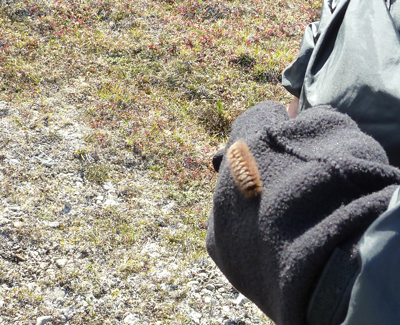By Dan Ritzman- Arctic Wild Guide, Conservation Leader and Lover of Caterpillars.

Woolly Bear Caterpillar on Gloved Hand
I have spent a good part of the last 2 decades talking to people about what makes the Arctic great. I have given hundreds of lectures, and toured any number of decision makers and media types around the Arctic and I always endeavor to mention the woolly-bear caterpillar and how beautifully adapted to its environment it is. When I am guiding trips for Arctic Wild one of the highlights is finding a woolly-bear on a hike. I get everyone to kneel down in the tundra and look at this tiny creature crawling amongst the cotton grass, forget-me-knots, and moss campion. Now don’t get me wrong I would never neglect the hundreds of thousands of caribou, or the other symbols of wilderness like the wolves and wolverines, but the magic of the Arctic comes in all sizes.
The arctic woolly-bear caterpillars are unique in their combination of fascinating adaptations to the polar extremes. They spend nearly 90% of their life frozen and only about 5% feeding on the tundra during the month of June; the remainder is spent in summer “hibernation” inside protective cocoons. Seriously, they spend 90% of their life frozen. This alone makes these little guys fascinating, but they are also the longest lived caterpillar species on the planet. Wooly-bears in the Alaskan Arctic can “live” for 7 years and the ones they have studied in the Canadian high Arctic can live to be 13 years old. Think about it! When one comes across a woolly-bear on a hike across the tundra this tiny “cute” little caterpillar has spent 7 years of freezing and thawing, and freezing and thawing, alive. This seems to be the stuff of a science fiction movie, but it is simply one of the truly wonderful adaptations that allow life to exist in the far north.
In the early 2000s when the Bush Administration had their sights set on drilling in the Arctic Refuge, I had what I still consider my greatest media summer. I was able to get the woolly-bear mentioned in stories that ran in Newsweek magazine, the Los Angeles Times, and Canada’s Globe and Mail.
Soon this amazing story will get even more attention. The Discovery Channel will be airing Frozen Planet, a seven part documentary produced in conjunction with the BBC. My organization, the Sierra Club, is partnering with Discovery to use Frozen Planet to spread the word about the need to conserve the special places and creatures of the Arctic and I have been lucky enough to get a sneak peak at some of the episodes. The episode titled “Spring” features truly amazing footage of the woolly-bear shot over the course of a number of seasons as it feeds, hibernates, freezes and thaws. I urge you to seek out Frozen Planet and see for yourself how amazing life in the earth’s freezer can be. Better yet, if you join Arctic Wild on a trip like the Kongakut to the Coast or Caribou Base Camp, you will have the chance to hold one of the world’s most perfectly adapted creatures in the palm of your hand.
To find out more about Frozen Planet and the Sierra Club’s efforts to protect America’s Arctic check out this link: www.action.sierraclub.org/frozenplanet


